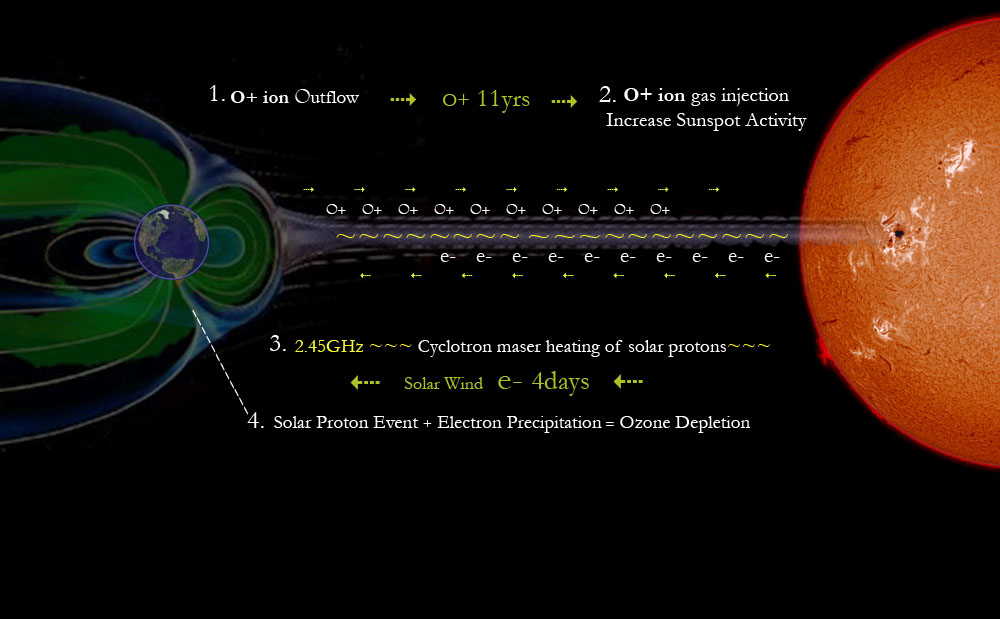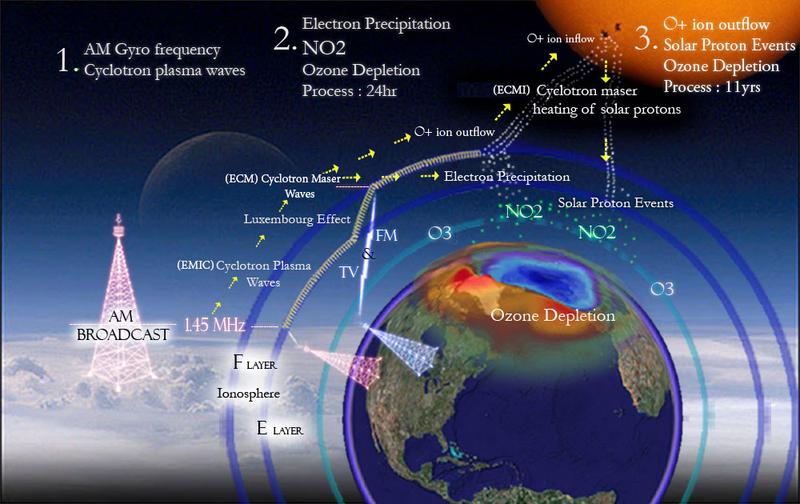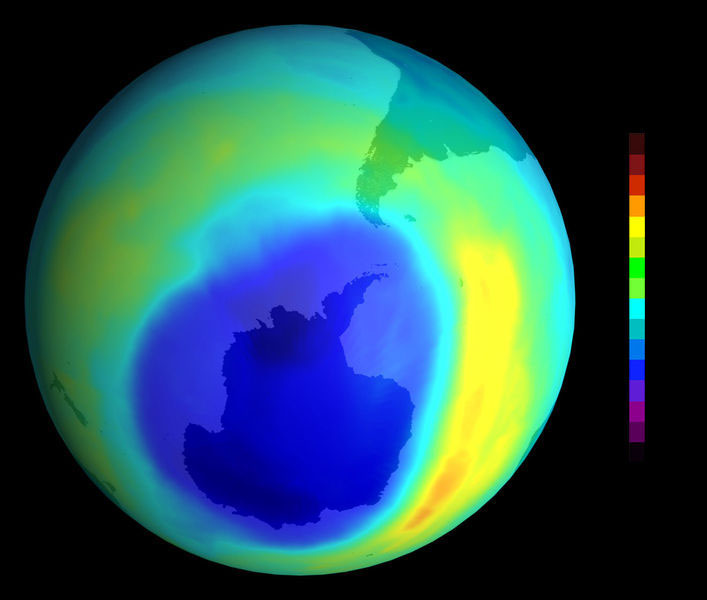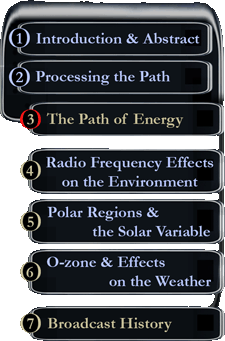Path of Energy ~ in a nutshell
Broadcast Theory follows a complex path of energy from transmitter induced ozone depletion to the greenhouse effect from increased UV.
TIPER: Transmitter Induced Electron Precipitation - It begins with the tens of thousands of megawatts of broadcast radio, TV, utility and radar station in use on the surface of the earth. And more specifically the broadcast transmitter at a VLF or AM radio station that irradiates the E layer of the ionosphere with electromagnetic energy in the gyrofrequency range at 1.45 MHz transfering it’s energy through the magnetic field lines in the ionospheric plasma in the form of ion cyclotron waves that travel along the field lines toward the polar regions stimulating EEP.
EIC: Electrostatic Ion Cyclotron Waves - [E layer ~2 - 4MHz] ~1.45MHz Gyrofrequency Bailey Effect
As EIC ionospheric plasma turbulence travels northward through the E layer toward the polar regions it undergoes amplification (preferential magnetospheric amplification), where the magnetic field lines from the magnetosphere cross the ionosphere, it causes two populations of charged particles to flow out. One of them is a runaway population of electrons and ions from the ionosphere caused by the effects of the amplified cyclotron wave turbulence. The other is a population of relativistic electrons that precipitate from the magnetosphere.
ECM: Electron Cyclotron Maser Waves and heating of solar wind - [F layer ~ 30MHz - 220MHz] [3MHz - Gyro]
Television and FM broadcast increases the electron density causing EIC waves to upshift to the ionosphere's F layer
(Luxembourg Effect) generating higher frequency plasma turbulence and ECM beams in the auroral region. The RF frequency induced turbulence change solar-terrestrial flux tube morphology and flow up the magnetic field lines toward the sun as cyclotron maser frequency waves. ECM heating of solar protons changes the pressure in the fast solar wind and the particles that flow through it. This can lead to kink instability closer to the sun and a backscatter of ions that boil the photosphere and heat oxygen gas in the convective zone of the sun contributing to sunspots. Sunspots throw energy back at the planet in the form of solar proton events that deplete ozone through the EEP-NOx process.
Electron Precipitation: EEP-NOx - Polar ionospheric outflows disrupts the electronegativity and hydrodynamic equilibrium that the ozone layer rely on for production (Chapman Cycle) and relativistic electrons slowed by atoms in the atmosphere generate soft X-ray 'bremsstrahlung' (breaking radiation) which hit stratospheric nitrogen atoms that break into nitrogen ions that react with the surrounding oxygen and form Nitrogen Oxide/Dioxide >NOx.
This rips apart thousands of ozone molecules as much as CFC’s or solar proton events SPEs.
Ozone Depletion and Greenhouse Effect: The decrease in ozone through EEP-NOx increases the amount of solar UV radiation that heats polar ice caps and oceans to increase atmospheric water vapor. Increasing solar UV heats greenhouse gases like CO2 and water vapor leading to a greenhouse effect and global temperature rise.
Broadcast transmitter ~ Detailed in RF Effects.. Next Page
1. The transfer of energy from AM broadcast through the gyrofrequency and the generation of
The transfer of energy from AM broadcast through the gyrofrequency and the generation of
electrostatic ion cyclotron (EIC) plasma wave turbulence along the magnetic field lines.
2. Multiples of the gyrofrequency above the 2nd gyro harmonic cause a suppression of the EIC plasma waves along the magnetic field line.
Multiples of the gyrofrequency above the 2nd gyro harmonic cause a suppression of the EIC plasma waves along the magnetic field line.
3. Television and FM broadcast fall in this suppression band and cause hybrid waves that overdrive the
Television and FM broadcast fall in this suppression band and cause hybrid waves that overdrive the
ionosphere and increase the electron density.
4. The increase of electron density due to TV and FM act as a conductive bridge for the AM energy to
The increase of electron density due to TV and FM act as a conductive bridge for the AM energy to
jump to a higher path of energy. aka Luxembourg effect (cross modulation)
Polar Regions ~ Detailed in Polar Regions Page
1. EIC waves cause electron precipitation which at relativistic energies generates X-ray 'bremsstrahlung' (breaking radiation) which interacts with stratospheric nitrogen creating NO/NO2 and OH that depletes ozone.
EIC waves cause electron precipitation which at relativistic energies generates X-ray 'bremsstrahlung' (breaking radiation) which interacts with stratospheric nitrogen creating NO/NO2 and OH that depletes ozone.
2. EIC waves cause density fluctuations in polar oxygen and creates RF heating along magnetic field lines toward the sun.
EIC waves cause density fluctuations in polar oxygen and creates RF heating along magnetic field lines toward the sun.
3. The cyclotron maser heating flows up flux tubes well into the convective zone causing sunspots.
The cyclotron maser heating flows up flux tubes well into the convective zone causing sunspots.
4. These sunspots in turn throw energy back at earth in the form of solar proton events that further
These sunspots in turn throw energy back at earth in the form of solar proton events that further
deplete ozone.
O ~ zone ~ Detailed in Ozone Page
1. Electron precipitation which at relativistic energies generates X-ray 'bremsstrahlung' (breaking radiation) which interacts with stratospheric nitrogen creating NO/NO2 and OH which deplete the stratospheric ozone layer.
Electron precipitation which at relativistic energies generates X-ray 'bremsstrahlung' (breaking radiation) which interacts with stratospheric nitrogen creating NO/NO2 and OH which deplete the stratospheric ozone layer.
2. Electron precipitation disrupt the hydrodynamic equilibrium and increases the electron density which
Electron precipitation disrupt the hydrodynamic equilibrium and increases the electron density which
3. The effects of ozone depletion increases incoming solar UV radiation causing the evaporation of ocean water into vapor and heats it along with greenhouse gases such as CO2 in the greenhouse effect.
The effects of ozone depletion increases incoming solar UV radiation causing the evaporation of ocean water into vapor and heats it along with greenhouse gases such as CO2 in the greenhouse effect.
4. Broadcast television clamps the ion acoustic turbulence resulting in the reduction in the EEP-NOx/ozone depletion and subsequent UV-GHG ~ greenhouse effect. This can be seen in the global temperature graph as well as in weather reports and ocean oscillation cycles.
Broadcast television clamps the ion acoustic turbulence resulting in the reduction in the EEP-NOx/ozone depletion and subsequent UV-GHG ~ greenhouse effect. This can be seen in the global temperature graph as well as in weather reports and ocean oscillation cycles.
5. Powerline Harmonic Radiation (PLHR) effects the magnetospheric generation of cyclotron maser plasma
Powerline Harmonic Radiation (PLHR) effects the magnetospheric generation of cyclotron maser plasma
Click to Enlarge
The Path of Energy ~ Overview
Next click here
RF Effects
Research Sections
2. Cyclotron maser heating of solar protons in solar terrestrial flux tubes altering the speed of fast solar wind particles that lead to kinks in the flux tubes and energetic backscatter in the convective region of the sun.
1. Ionospheric ion outflows contribute to density shifts in polar ions and electrons while changing the charged currents of particles flowing through solar-terrestrial flux tubes as well as flux tube morphology.
Next click here
RF Effects
When E layer ionospheric plasma turbulence jumps or overflows into the F layer it can generate secondary VLF and more EEP-NOx.
Electrostatic Ion Cyclotron Wave:
In plasma physics, an electrostatic ion cyclotron wave is a longitudinal oscillation of the ions (and electrons) in a magnetized plasma, propagating nearly (but not exactly) perpendicular to the magnetic field.
In 1946 it was discovered that gyrofrequency stimulation of ionospheric plasma occurs using only 400 ~ 500 watts.
AM broadcast is limited to
50,000 watts.
See: Bailey Effect
400 ~ 500W




